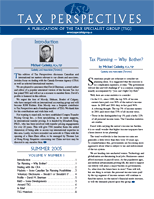
PDF Format
 Issue Contents Issue Contents
 All Issues All Issues
Summer 2005
Volume 5, Number 1
The information in Tax Perspectives is prepared for general interest only. Every effort has been made to ensure that the contents are accurate. However, professional advice should always be obtained before acting and TSG member firms cannot assume any liability for persons who act on the basis of information contained herein without professional advice.
R&D — Some Developments
Now is a good time to discuss both the old news and the new developments about the SR&ED program in Canada. The old news is that a lot of corporations for one reason or another still do not claim the federal and provincial tax credits that are available to them. Any corporation that makes or improves a product, or creates or improves a process should consider the program. The largest barrier is often the company's own employees who will say, "It can't be this easy" or "we do this all the time so it can't qualify as research." But, yes, often it does qualify, adding significant cash to the operations of the corporation in the form of tax refunds or credits. Briefly, the qualifications: - To describe current standard practice and then the departure from that standard practice that is a technological advance for the corporation.
- This advance must have an uncertainty as to its success, which must be described.
- Finally, the corporation must perform the research in a systematic documented manner in which it analyzes the competing alternative solutions to the uncertainty of achieving the technological advance.
Now the new development. CRA is revising the required form to claim the SR&ED tax credit, the T661. Most offices will accept the old form until July 31, 2005 and some offices will allow it until August 31, 2005. If you file an old form after that date, it will be returned to you. Using the old form can be very dangerous if you are filing close to the final deadline of 18 months after year-end. If you are in this situation and you did not use the new form, the outcome is that you could lose the opportunity to get the credit. The eventual goal of the change is to allow, in the future, the electronic filing of a tax return that has an SR&ED claim. We are not there yet, but this will happen in the future. We will keep you informed of the progress towards this end. The common practice of most R&D performers who are researching the method of building a new or improved product is to construct a prototype. Then one must determine if the prototype can be built economically and successfully on a full-scale production line. This is when the fun starts. The Income Tax Act does not clearly describe whether this portion of the activity is SR&ED. To exclude such costs, the CRA relies on the definition of commercial production, which is not eligible for SR&ED. To muddy the waters further, most corporations will either sell or try to realize some benefit from the prototype. After all, why not? Administratively, the CRA has developed two definitions to try to help with this difficult analysis. Experimental Development. This can be described as the creation of a prototype, including its sale before any commercial production has occurred. Then, to mirror real life, the second definition is Experimental Development with Commercial Production. This occurs when some aspect of SR&ED is performed on the production line while commercial production is occurring. Needless to say, the SR&ED eligible cost calculation is different in each case. For Experimental Production, all costs are eligible costs and fully earn a tax credit. For Experimental Production with Commercial Production, it becomes more complicated. An attempt must be made to calculate the cost of the component of the overall product, which is being researched. This part, and only this part, is an eligible cost. As long as a reasonable attempt is made, the method will be accepted. On each prototype, the corporation is still exposed to the potential of the claw back of the material cost, if the prototype is sold. But, the labour cost would still be an eligible cost for the SR&ED tax credit, not subject to the clawback, even if the prototype is sold. In practice, clients don't document nearly enough of "partial" SR&ED situations and it is here that real opportunity lies for most claimants.
|